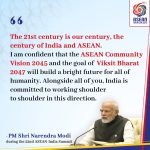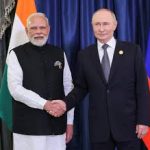Anything Indian has a Great Chance of Success
Berenice Ellena, the French clothes and costume designer who flits between Paris, Venice, New Delhi and Srinagar, has authored a splendid book on the magic of Indian textiles. Called India Sutra, the book is packed with detailed information for textile lovers and is lavishly illustrated with evocative photographs of Indian weavers and craftsmen engaged in creating fabrics that find their way to fashion capitals of the world.
Ellena, a passionate lover of India and all things Indian, weaves her narrative with myths and poetry surrounding the evolution of textiles in the country. In the process, she discovers ancestral techniques and different textile routes in today’s India. Her imaginative rendering of the history of textiles lifts the narrative to a spiritual and transcendent plane.
“According to the Upanishads, it is the thread that links man to the Gods. The thread is at one and the same time the soul (atma) and vital force (prana),” she writes in the introductory chapter to India Sutra: On the Magic Trail of Textiles (published by Shubhi Publications).
 Her passion and concern for Indian craftspeople shines though in every page of this elegantly produced book. But she is worried about what future holds for these inheritors of a centuries-old tradition in a globalized world.
Her passion and concern for Indian craftspeople shines though in every page of this elegantly produced book. But she is worried about what future holds for these inheritors of a centuries-old tradition in a globalized world.
“The first leaders of free India, imbued as they were with a great sense of social ethics, chose to use all available resources to stimulate the development of village industries, especially weaving,” writes Ellena. She contrasts this attitude of nurturing and patronage with the present indifference when some of them are dying due to neglect and a lack of marketing aptitude. “However, fifty odd years later, it appears the compulsions of power are such that the leaders of today are doing precious little to help weavers in difficulty. In the new millennium, India will soon have two billion hands to work with. With the new economic policy in place, what future will India offer to her craftspeople?” she asks.
In this interview, Ellena speaks about her tryst with the enchanting world of Indian textiles, her experience of working with weavers in different parts of the country and the burgeoning popularity of the Indian ethnic chic in fashion marts of the world. “Anything Indian has a great chance of success these days,” she says with the confident air of one who knows what it takes to script a success story in today’s globalised world.
Excerpts from the interview:
This garment so delicate
Which warp, which weft,
Which thread is it thus made?
Ingla, the warp of the moon, Pingla, the weft of the sun,
Sushumma, the subtle thread,
Eight petals of the lotus as spinning wheel,
Five elements to weave it with,
For all of ten months, the Master was busy at work,
Making the loom sing, He created the cloth.
Once worn, devotees and ascetics put it to bold use
And left their veil soiled.
But Kabir, Thy servant, has worn it with care,
As he received it, so he returns it.
Kabir Das, 15th century weaver and poet
Q) You are a costume designer and have done extensive research on textiles in different parts of the world. What drew you to Indian textiles?
A) I have been coming here for the last 30 years. All the fabrics were in Indian bazaars. There is something magical about Indian textiles and the kind of scrupulous attention to details one finds exhibited in these fabrics.
When I cam here first, I didn’t know how these fabrics were made. As a costume designer, we have to transform the fabric like a painter uses colours on his canvas. We have to trust and manipulate the fabric.
Q) You have worked with Indian weavers and craftspeople in different parts of India? What’s been your experience of working with them?
A) I have worked with Indian weavers and craftspeople in Rajasthan, Gujarat, Madhya Pradesh and Kashmir. These people are very human. Weavers are very aware of the things and their surroundings. They are enormously talented people with an intuitive sense of design and a feeling for fabrics. But they are very simple people. They need help with marketing.
Q) What kind of marketing help do these craftsmen need?
A) We are in a world of globalisation. People are travelling all the time. The world is literally becoming a global village. But there is a problem in marketing these people. If you are isolated, it’s very difficult to create a buzz. Besides, there is a lack of awareness about what’s needed in the market. What we need is a bridge between what these people design and what the market needs.
Q) Are people aware of the real-life situations of these weavers? For all the talk about ethnic chic, some of these people live in extreme poverty…
A) The sad thing is that due to indifference to their plight and poverty many of these craftsmen are starving and committing suicide. True, there is little awareness about their plight.
The middle class India doesn’t know what’s happening in the rest of India. But in many ways, the urban middle class is also a hope for Indian craftsman.
Q) Is ethnic chic still a rage among the fashionable crowd?
A) Instead of trying to copy what’s made in the US or the West, we should be original. Ethnic chic is the in thing and a fashion statement these days. We should try to make friendly eco-friendly fabric. If you are part of fashionable, intellectually aware crowd, you know what ethnic means.
Q) Is India generating a buzz in fashion circles abroad?
A) We love India, we love the diversity of India. Big fashion houses abroad are enormously interested in India. Wherever you go, you notice the incredible popularity of Indian art and culture. Anything Indian has a great chance of success these days. Hermes has worked with leather and fabrics in Gujarat.
Q)You have travelled extensively all over the world and you have been coming to India over the last three decades. Do you think India’s image has changed in the world?
A) India is coming up in a very substantial way in France. But it’s not taking advantage of the situation for its people. I love India and have great hope from this country. I sincerely hope that one day everyone in India will have enough to feed his family and pay for his children’s education.
Author Profile

- Manish Chand is Founder and Editor-in-Chief of India Writes Network (www.indiawrites.org) and India and World, a pioneering magazine focused on international affairs. He is CEO, Centre for Global India Insights, an India-based think tank focused on global affairs.
Latest entries
 India and the WorldOctober 27, 2025Modi hails the century of India and ASEAN, backs ASEAN centrality
India and the WorldOctober 27, 2025Modi hails the century of India and ASEAN, backs ASEAN centrality India and the WorldOctober 26, 2025Act East: Five reasons why ASEAN summit in Malaysia matters
India and the WorldOctober 26, 2025Act East: Five reasons why ASEAN summit in Malaysia matters India and the WorldOctober 25, 2025Malaysia Summit: India can play a bigger role in ASEAN: Anil Wadhwa
India and the WorldOctober 25, 2025Malaysia Summit: India can play a bigger role in ASEAN: Anil Wadhwa India and the WorldOctober 2, 2025With US frowning, India to host Putin in December
India and the WorldOctober 2, 2025With US frowning, India to host Putin in December







